
Fashion is a form of self-expression and autonomy at a particular period and place and in a specific context, of clothing, footwear, lifestyle, accessories, makeup, hairstyle, and body posture. The term implies a look defined by the fashion industry as that which is trending. Everything that is considered fashion is available and popularized by the fashion system.

Victorian fashion consists of the various fashions and trends in British culture that emerged and developed in the United Kingdom and the British Empire throughout the Victorian era, roughly from the 1830s through the 1890s. The period saw many changes in fashion, including changes in styles, fashion technology and the methods of distribution. Various movement in architecture, literature, and the decorative and visual arts as well as a changing perception of gender roles also influenced fashion.
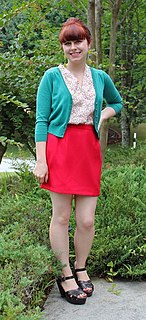
A miniskirt is a skirt with its hemline well above the knees, generally at mid-thigh level, normally no longer than 10 cm (4 in) below the buttocks; and a dress with such a hemline is called a minidress or a miniskirt dress. A micro-miniskirt or microskirt is a miniskirt with its hemline at the upper thigh, at or just below crotch or underwear level.
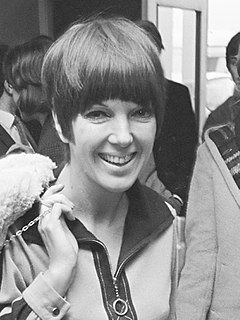
Dame Barbara Mary Quant, Mrs Plunket Greene, is a British fashion designer and fashion icon. She became an instrumental figure in the 1960s London-based Mod and youth fashion movements. She was one of the designers who took credit for the miniskirt and hotpants. Ernestine Carter wrote: "It is given to a fortunate few to be born at the right time, in the right place, with the right talents. In recent fashion there are three: Chanel, Dior, and Mary Quant."

Count Hubert James Marcel Taffin de Givenchy was a French aristocrat and fashion designer who founded the house of Givenchy in 1952. He is famous for having designed much of the personal and professional wardrobe of Audrey Hepburn and clothing for Jacqueline Bouvier Kennedy. He was named to the International Best Dressed List Hall of Fame in 1970.
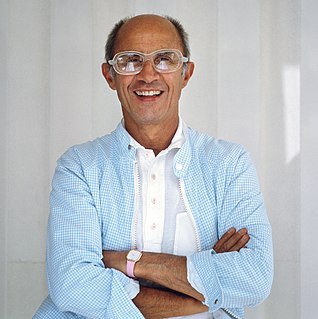
André Courrèges was a French fashion designer. He was particularly known for his streamlined 1960s designs influenced by modernism and futurism, exploiting modern technology and new fabrics. Courrèges defined the go-go boot and along with Mary Quant, is one of the designers credited with inventing the miniskirt.
Balenciaga SAS is a luxury fashion house founded in 1919 by the Spanish designer Cristóbal Balenciaga in San Sebastian, Spain and bought afterwards by French luxury group Kering. Balenciaga had a reputation as a couturier of uncompromising standards and was called "the master of us all" by Christian Dior. His bubble skirts and odd, feminine, yet "modernistic" silhouettes became the trademarks of the house. Balenciaga closed in 1972 and was reopened under new ownership in 1986. Owned by Kering, Balenciaga headquarters are based in Paris.
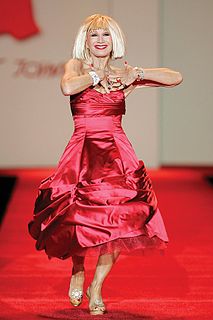
Betsey Johnson is an American fashion designer best known for her feminine and whimsical designs. Many of her designs are considered "over the top" and embellished. She also is known for doing a cartwheel ending in a split at the end of her fashion shows.
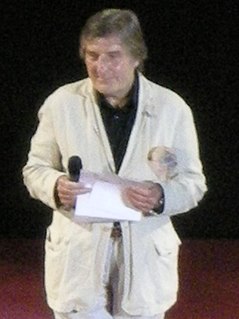
Emanuel Ungaro was a French fashion designer who founded the eponymous fashion house in 1965.

Fashion of the 1960s featured a number of diverse trends, as part of a decade that broke many fashion traditions, adopted new cultures, and launched a new age of social movements. Around the middle of the decade, fashions arising from small pockets of young people in a few urban centers received large amounts of media publicity, and began to heavily influence both the haute couture of elite designers and the mass-market manufacturers. Examples include the mini skirt, culottes, go-go boots, and more experimental fashions, less often seen on the street, such as curved PVC dresses and other PVC clothes.

Fashion in the 1970s was about individuality. In the early 1970s, Vogue proclaimed "There are no rules in the fashion game now" due to overproduction flooding the market with cheap synthetic clothing. Common items included mini skirts, bell-bottoms popularized by hippies, vintage clothing from the 1950s and earlier, and the androgynous glam rock and disco styles that introduced platform shoes, bright colors, glitter, and satin.

History of fashion design refers specifically to the development of the purpose and intention behind garments, shoes and accessories, and their design and construction. The modern industry, based around firms or fashion houses run by individual designers, started in the 19th century with Charles Frederick Worth who, beginning in 1858, was the first designer to have his label sewn into the garments he created.

Go-go boots are a low-heeled style of women's fashion boot first introduced in the mid-1960s. The original go-go boots, as defined by André Courrèges in 1964, were white, low-heeled, and mid-calf in height, a specific style which is sometimes called the Courrèges boot. Since then, the term go-go boot has come to include the knee-high, square-toed boots with block heels that were very popular in the 1960s and 1970s; as well as a number of variations including kitten heeled versions and colours other than white. In A Pup Named Scooby-Doo, Daphne Blake wore a white pair of go-go boots in her young adolescence, she would complain from time to time about them getting dirty and they always happened to be new.
Yves Saint Laurent SAS, also known as Saint Laurent, is a French luxury fashion house founded by Yves Saint Laurent and his partner, Pierre Bergé. The company revived its haute couture collection in 2015 under former Creative Director Hedi Slimane. In April 2016, Anthony Vaccarello was appointed as creative director.
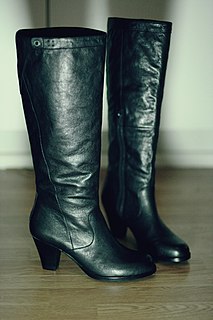
A fashion boot is a boot worn for reasons of style or fashion. The term is usually applied to women's boots. Fashion boots come in a wide variety of styles, from ankle to thigh-length, and are used for casual, formal, and business attire. Although boots were a popular style of women's footwear in the 19th century, they were not recognized as a high fashion item until the 1960s. They became widely popular in the 1970s and have remained a staple of women's winter wardrobes since then.
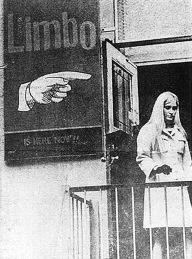
Limbo was a boutique which was opened in 1965 by Martin (Marty) Freedman, originally at 24 St. Mark's Place between Second and Third Avenues in the East Village neighborhood of Manhattan, New York City. The shop moved to 4 St. Mark's Place on the same block in 1967, and closed in 1975.
Oversized fashion, distinct from plus-sized fashion, consists of clothing and other accessories that are larger than normal and reflect some sort of attitude, message, or trend of the period at hand. While oversized fashion trends from the 1920s to the turn of the century vary from decade to decade, there are many overarching themes that have been expressed during the past one hundred or so years. Masculinity, for example, has played a large role in many of the underlying communications of the fashions, although virility is manifested differently in the clothing depending on the era. Oversized fashion production, furthermore, runs largely parallel with the states of the American and global economies. Modernly, oversized fashion has taken on a new form - primarily in the realm of oversized accessories.

Fashion and clothing in the Philippines refers to the way the people of Filipino society dress up in instances such as while they are at home, at work, travelling and when attending special occasions.
Fashion activism is the practice of using fashion as a medium for social, political, and environmental change. The term has been used recurringly in the works of designers and scholars Lynda Grose, Kate Fletcher, Mathilda Tham, Kirsi Niinimäki, Anja-Lisa Hirscher, Zoe Romano, and Orsola de Castro, as they refer to systemic social and political change through the means of fashion. It is also a term used by some fashion designers, one being Stella Mccartney. The spectacle of fashion activism as street protest has also been a theme in Paris Catwalk shows, perhaps most noted in Chanel's spring/summer 2015 show, designed by Karl Lagerfeld. The term is also popularly used by Céline Semaan, co-founder of the Slow Factory Foundation.
Steven Khalil is an Australian bridal and red carpet fashion designer, known for his bridal and red carpet gowns. Khalil launched his own fashion brand in 2003, 'Steven Khalil', and has since gained popularity. His designs have been worn by many Australian and International celebrities such as Samantha Jade, Giuliana Rancic, Dannii Minogue, Ariel Winter, Jessica Mauboy, Paula Abdul, Kylie Jenner, Khloe Kardashian, Kris Jenner, Jennifer Lopez, Kelly Preston, Emily Ratajkowski, Carrie Underwood, Princess Olympia of Greece, Georgia Fowler and Jesinta Campbell.
















